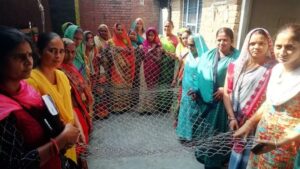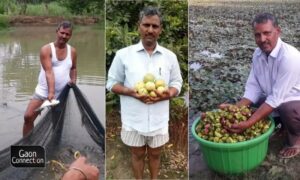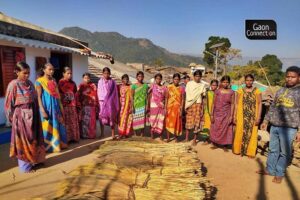Coimbatore, Tamil Nadu.
May 24, 2020. The COVID-19 pandemic notwithstanding, a group of citizens, masks in place, gathered on the edge of a 10.87 acre-land with construction debris, garbage and broken shards of bottles strewn around. “A preliminary round of cleaning has been done and soon we can start planting the saplings,” an excited Aparna Sunku, the then secretary of one of the Rotary Clubs in Coimbatore, told Gaon Connection. Soon this patch of wasteland, handed over by the Indian Railways, will be covered with over 30,000 saplings to convert it into a mini urban forest.
The forest will be called Hope Vanam, a forest of hope, she added.
Despite the pandemic, citizen-driven tree planting drives in Coimbatore, the second largest city in the southern state of Tamil Nadu, located about 500 kms from its capital, Chennai, haven’t lost steam. On May 24, a small puja formally launched the project and discussions got underway about planting the saplings in mid-September. But before that a lot of work had to be completed.
“There was nearly four feet of debris that had to be excavated from the site before the soil came into view. A bund was also built with sand, vetiver and stones to filter treated sewage water that will be used to water the saplings,” said V Chandrasekar who heads afforestation projects of an environmental non-profit, Siruthuli (meaning a water droplet) that is providing the expertise for the Hope Vanam.
“Come next week and we will be planting nearly 25 species of native trees including Neem, Pungan, Orchid tree, Star gooseberry and Vilva,” landscape consultant for the project, Shanthini B told Gaon Connection. It was Shanthini, along with Sujani Balu of Siruthuli, who readied the soil at the 10- acre plot to receive the saplings. “We have to give the soil time to heal from all the toxic waste that has been dumped on it for years. Pits are hollowed out, nourished, the soil is allowed to breathe free and only then are the saplings planted,” Balu explained.
Once complete, Hope Vanam will get added to the list of vanams citizens have already created in Coimbatore over the last two decades, including Kalam Vanam, Bhararthi Vanam, a vanam of 7,000 trees at the Central Reserve Police Force campus, and another 10,000 trees vanam at the Coimbatore Central Prison.
From water to trees
The non-profit Siruthuli, meaning water droplet in Tamil, was born in 2003 out of Coimbatore residents’ desire to do something about the dire water shortage in the city.
“The monsoons had failed for three consecutive years and groundwater had depleted alarmingly,” Vanitha Mohan, managing trustee of Siruthuli, told Gaon Connection. A few like minded people including doctors, educationists, industrialists and business communities, concerned about the environmental wellbeing of the city, began identifying derelict ponds, dried lakes and abandoned wells and borewells.
With the help of the local administration, the non-profit has restored nearly 27 tanks till date. This, to some extent, has accentuated the water crisis in the city, as these revived tanks hold rainwater and recharge the groundwater.
The members of Siruthuli didn’t want to stop with just revival of their water bodies. Together, with active support of the local residents, they decided to take up afforestation drives, which was a logical extension of water conservation works. “The city was growing exponentially and trees were the first victims,” said Mohan. For example, in 2005, the population of Coimbatore and its adjacent suburban areas was 1.82 million. In 2020 it is estimated to be 2.78 million.
Green honour
The residents of Coimbatore have missed no occasion to green their city. In 2005, when late President APJ Abdul Kalam visited the city he planted a Peepal tree (ficus religiosa).
Siruthuli promised Kalam it would plant 80,000 saplings more in time for his 80th birthday. And, went ahead to do so. In the coming few years, a hundred thousand trees were planted in panchayat poramboke lands, private sites and roadside avenues.
Six years later, on his 80th birthday in October 2011, Kalam re-visited the city and commemorated it by planting another sapling, this time of a Jamun tree (Naaval in Tamil), in a place called Nandangarai. This was no ordinary sapling but was from a tree that was planted by Mahatma Gandhi in the 1930s when he came to Coimbatore.
Miyawaki method of urban forestation
The success of the greening drives in the city, initially, was mixed. While some saplings were nurtured by neighbourhoods and allowed to grow into trees, others were damaged or wilfully destroyed. The non-profit, Siruthuli, had to return to the drawing board and come up with tamper-proof alternatives and also find enough land to continue with its greening drive.
Then it came across Miyawaki, a new concept of urban forestation that is gaining pace not just in India, but several other countries. It is a method recommended by Japanese botanist Akira Miyawaki, where saplings of native trees are densely packed into small spaces.
Less than five years ago, Coimbatore-based Anna University campus in the city was bare and dry. But now it boasts of 80,000 trees planted by the Miyawaki method. In the honour of the late President, this urban forest is called Kalam Vanam. “We have planted as few as 70 trees in a small strip of land in a school, and as many as 80,000 in the campus of Anna University beginning in the year 2016 which is now a mini forest,” Chandrasekar told Gaon Connection.
Taking its cue from the success of this project, Bharathiar University, Coimbatore, organised a huge event last year where 5,000 students from 20-30 institutions planted 10, 000 saplings in three minutes in order to create another urban forest called Bhararthi Vanam.
After Coimbatore, the greening of Tiruppur
Soon the word of green initiatives of Coimbatore residents reached Tiruppur, a major textile and knitwear hub, about 40 kms east of Coimbatore. Five years ago, in July 2015, textile exporters, manufacturers and other industrialists there decided to get together and green their dusty and dry city. They started a movement called Vanathukul Tiruppur, which means Tiruppur within a forest in Tamil. Like it was in Coimbatore, the Vanathukul Tiruppur was a homage to late President Kalam.
“In 2005, we were 25 of us, but today we have 200 donors, scientists, government officials, journalists and green volunteers who are putting their heart and soul into restoring the city’s green cover. We set ourselves the target of planting and nurturing one lakh trees,” TR Sivaraman, one of the founder members of the movement, told Gaon Connection. He is also the managing director of Classic Polo, a leading men’s wear brand.
“Between 2015 and 2019, Vanathukul Tiruppur planted eight lakh saplings of native species in 1,800 acres of private land in and around the town. This year, we have set our target at two lakh saplings by December,” informed Sivaraman. “We are dreaming of touching a million trees in our city in six years,” he added. Industrialists in Tiruppur are spending almost a crore rupees every year for afforestation and it won’t be long before the area will be known for the best quality of air and green aura, he declared.
To monitor its greening initiative, Vanathukkul Tiruppur sought the help of a Coimbatore-based environmental agency, Siddharth Foundation, that conducted a microanalysis of 70 sites out of the total of 500 sites in Tiruppur. “We had planted 48 native species of saplings and after five years, the survey revealed there were now 169 new species of shrubs, herbs and climbers, besides a large number of insects, reptiles and birds. Vegetation has improved and so has the quality of the soil that now holds more moisture,” claimed Sivaraman.
Meanwhile, inspired by the Hope Vanam of Coimbatore, Rotary Clubs in Theni and Madurai want to green their cities, too. They reached out to Chandrasekar last fortnight and he explained the Miyawaki method to them in a video conference. “They have just informed me they have acquired about 5.5 acres area for the project, have finalised the budget, and will be planting native species using the Miyawaki method,” said Chandrasekar, happily, to Gaon Connection. He also added that in the coming weeks 10,000 saplings more will be planted at the forest in Central Prison and another 30,000 at the CRPF campus in Coimbatore.
Tracking the saplings
Often, the first question that is raised around any tree plantation drive is what if the lakhs of planted saplings don’t grow into mature trees? To address this issue, a novel tree certificate scheme is adding to the people’s investment in the greening drives in Coimbatore. For instance, citizens can sponsor a sapling, get a tree certificate with a QR code in return, and use it to watch their sapling grow from any corner of the world.
“Anyone can sponsor a sapling for Rs 500 and get a tree certificate with a QR code and her or his name on it. Scan the QR code, and no matter where in the world you are, you can see how your tree is doing,” city chronicler and jeweller, Rajesh Govindarajulu told Gaon Connection. He has campaigned enthusiastically for the tree certificate initiative.
“A community of jewellers in Coimbatore nurtured 2,500 saplings that were planted at the Anna University Campus in their presence and were gifted the tree certificates with QR codes,” explained Govindarajulu who, along with his friends, recently sponsored 60 trees for a pal’s 60th birthday. Similarly, D Murali of Kanakalakshmi Diamonds, gifts tree certificates to his important clients. “It is not always the big sponsorships that make a difference. I think the role of ordinary citizens like us is as significant. We are all tree ambassadors,” he concluded. According to Mohan, it doesn’t take a lot to grow a tree. All it requires is a commitment from each one of us. “Plant trees along your compound wall, or have a small Miyawaki in a corner. It is the people who make green cities possible,” she said.



















